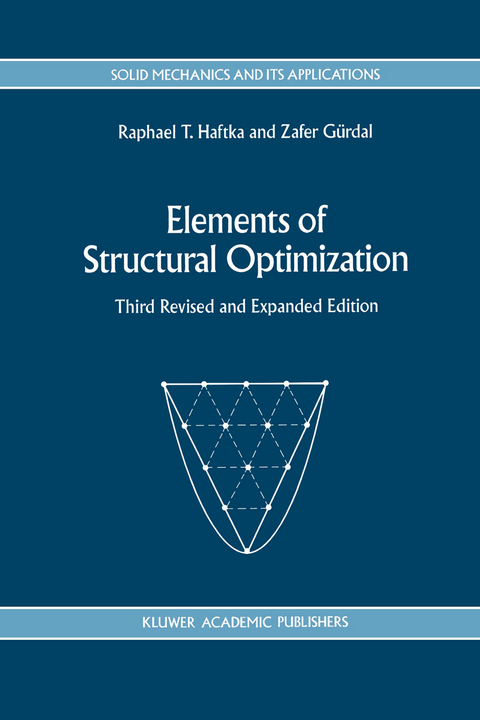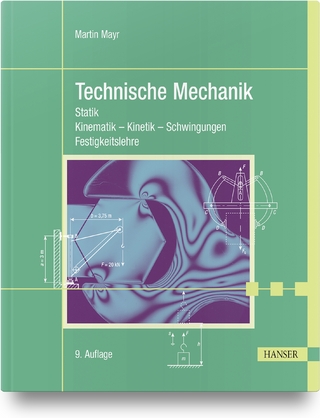
Elements of Structural Optimization
Springer (Verlag)
978-0-7923-1505-6 (ISBN)
The field of structural optimization is still a relatively new field undergoing rapid changes in methods and focus. Until recently there was a severe imbalance between the enormous amount of literature on the subject, and the paucity of applications to practical design problems. This imbalance is being gradually redressed. There is still no shortage of new publications, but there are also exciting applications of the methods of structural optimizations in the automotive, aerospace, civil engineering, machine design and other engineering fields. As a result of the growing pace of applications, research into structural optimization methods is increasingly driven by real-life problems. t-.Jost engineers who design structures employ complex general-purpose software packages for structural analysis. Often they do not have any access to the source program, and even more frequently they have only scant knowledge of the details of the structural analysis algorithms used in this software packages. Therefore the major challenge faced by researchers in structural optimization is to develop methods that are suitable for use with such software packages. Another major challenge is the high computational cost associated with the analysis of many complex real-life problems. In many cases the engineer who has the task of designing a structure cannot afford to analyze it more than a handful of times.
1. Introduction.- 1.1 Function Optimization and Parameter Optimization.- 1.2 Elements of Problem Formulation.- 1.3 The Solution Process.- 1.4 Analysis and Design Formulations.- 1.5 Specific Versus General Methods.- 1.6 Exercises.- 1.7 References.- 2. Classical Tools in Structural Optimization.- 2.1 Optimization Using Differential Calculus.- 2.2 Optimization Using Variational Calculus.- 2.3 Classical Methods for Constrained Problems.- 2.4 Local Constraints and the Minmax Approach.- 2.5 Necessary and Sufficient Conditions for Optimality.- 2.6 Use of Series Solutions in Structural Optimization.- 2.7 Exercises.- 2.8 References.- 3. Linear Programming.- 3.1 Limit Analysis and Design of Structures Formulated as LP Problems.- 3.2 Prestressed Concrete Design by Linear Programming.- 3.3 Minimum Weight Design of Statically Determinate Trusses.- 3.4 Graphical Solutions of Simple LP Problems.- 3.5 A Linear Program in a Standard Form.- 3.6 The Simplex Method.- 3.7 Duality in Linear Programming.- 3.8 An Interior Method—Karmarkar’s Algorithm.- 3.9 Integer Linear Programming.- 3.10 Exercises.- 3.11 References.- 4. Unconstrained Optimization.- 4.1 Minimization of Functions of One Variable.- 4.2 Minimization of Functions of Several Variables.- 4.3 Specialized Quasi-Newton Methods.- 4.4 Probabilistic Search Algorithms.- 4.5 Exercises.- 4.6 References.- 5. Constrained Optimization.- 5.1 The Kuhn-Tucker Conditions.- 5.2 Quadratic Programming Problems.- 5.3 Computing the Lagrange Multipliers.- 5.4 Sensitivity of Optimum Solution to Problem Parameters.- 5.5 Gradient Projection and Reduced Gradient Methods.- 5.6 The Feasible Directions Method.- 5.7 Penalty Function Methods.- 5.8 Multiplier Methods.- 5.9 Projected Lagrangian Methods (Sequential Quadratic Prog.).- 5.10 Exercises.- 5.11References.- 6. Aspects of the Optimization Process in Practice.- 6.1 Generic Approximations.- 6.2 Fast Reanalysis Techniques.- 6.3 Sequential Linear Programming.- 6.4 Sequential Nonlinear Approximate Optimization.- 6.5 Special Problems Associated with Shape Optimization.- 6.6 Optimization Packages.- 6.7 Test Problems.- 6.8 Exercises.- 6.9 References.- 7. Sensitivity of Discrete Systems.- 7.1 Finite Difference Approximations.- 7.2 Sensitivity Derivatives of Static Displacement and Stress Constraints.- 7.3 Sensitivity Calculations for Eigenvalue Problems.- 7.4 Sensitivity of Constraints on Transient Response.- 7.5 Exercises.- 7.6 References.- 8. Introduction to Variational Sensitivity Analysis.- 8.1 Linear Static Analysis.- 8.2 Nonlinear Static Analysis and Limit Loads.- 8.3 Vibration and Buckling.- 8.4 Static Shape Sensitivity.- 8.5 Exercise.- 8.6 References.- 9. Dual and Optimality Criteria Methods.- 9.1 Intuitive Optimality Criteria Methods.- 9.2 Dual Methods.- 9.3 Optimality Criteria Methods for a Single Constraint.- 9.4 Several Constraints.- 9.5 Exercises.- 9.6 References.- 10. Decomposition and Multilevel Optimization.- 10.1 The Relation between Decomposition and Multilevel Formulation.- 10.2 Decomposition.- 10.3 Coordination and Multilevel Optimization.- 10.4 Penalty and Envelope Function Approaches.- 10.5 Narrow-Tree Multilevel Problems.- 10.6 Decomposition in Response and Sensitivity Calculations.- 10.7 Exercises.- 10.8 References.- 11.Optimum Design of Laminated Composite Materials.- 11.1 Mechanical Response of a Laminate.- 11.2 Laminate Design.- 11.3 Stacking Sequence Design.- 11.4 Design Applications.- 11.5 Design Uncertainties.- 11.6 Exercises.- 11.7 References.- Name Index.
| Erscheint lt. Verlag | 30.11.1991 |
|---|---|
| Reihe/Serie | Solid Mechanics and Its Applications ; 11 |
| Zusatzinfo | XIV, 481 p. |
| Verlagsort | Dordrecht |
| Sprache | englisch |
| Maße | 160 x 240 mm |
| Themenwelt | Naturwissenschaften ► Physik / Astronomie ► Mechanik |
| Technik ► Bauwesen | |
| ISBN-10 | 0-7923-1505-7 / 0792315057 |
| ISBN-13 | 978-0-7923-1505-6 / 9780792315056 |
| Zustand | Neuware |
| Haben Sie eine Frage zum Produkt? |
aus dem Bereich


